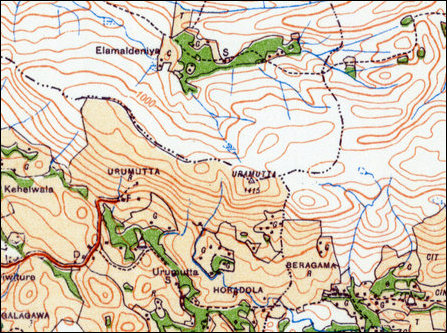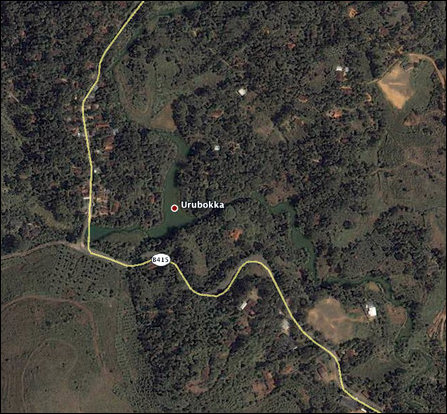Know the Etymology: 176
Place Name of the Day: Thursday, 23 December 2010
U’rukaamam, Urugamuwa, Urumutta
உறுகாமம், உருகமுவ, உருமுட்ட
Uṟukāmam, Urugamuva, UrumuṭṭaU’ru+kaamam
Uru+gamuwa
The big village
The big hill or peak
| U’ru |
(adjective, adverb) Much, abundant, to be numerous (Tamil, Dravidian Etymological Dictionary 711); An Urichchol word meaning great, large, big, much, etc (Tamil, Tholkaappiyam, 17:3); Plenty, copious, much, abundant (Malayalam, DED 711); U’ruvu, Urubu: Largeness (Kannada, DED 711); Uruvu: Magnitude, largeness, bigness, amount, sum, great, big (Telugu, DED 711); Uru: (adjective) Large, great (Sinhala) |
| Kaamam |
Village (Eezham Tamil); Gamuwa, Gama: (singular), Gam (plural): Village (Sinhala); Gaama: Village (Pali/ Prakrit); Gaamaka: Small village (Pali/ Prakrit); Gan, Gamun, gamah, gamuge: Island, land, village, hamlet, domicile (Dhivehi/ Maldivian), Graama: An inhabited place, village, hamlet, inhabitants of a place, community, race (Sanskrit)
|
| Mutta |
Hill, peak (Sinhala place names); Muddu: Rising ground, high ground, heap (Tamil, DED 5058); Meddu: Mound, heap of earth (Tamil, DED 5058); Meadu: Height, eminence, hillock, rising ground (Tamil/ Malayalam, DED 5058); Mitte: Rising ground, hill, state of being high, mass (Tiyya dialect of Malayalam, DED 5058); Mittaal: Rising ground, an alluvial bank (Malayalam); Mutte: Heap (Tulu, DED 5058); Metta: Raised or high ground, hill (Telugu, DED 5058); Mettu: Mound (Telugu, DED 5058); Mitta: High ground, hillock, mound (Telugu, DED 5058); Mettaa: Hill, hillock (Kolami, DED 5058); Meta: Hillock (Konda, DED 5058); Sand hill (Kuvi, DED 5058); Mutaa: Island (An Etymological Dictionary of Maldivian Island Names 0814, p78); Mukadu, Moadu: Top, top of a hill, ridge of a roof, top of a house, hill (Tamil, DED 4888); Mudi: Top as of mountain (Tamil, DED 4921); Place name component for hills having prominent peaks (Kerala, Tamil Nadu); Malai-muddam: Hill top or hill side (Tamil, Perugkathai 107:43)
|
There are a few Tamil and Sinhala place names in the island that have the prefix U’ru/ Uru. The presence of the component is significant in understanding the relationship between Tamil and Sinhala.
U’ru, written with a retroflex ‘R in Tamil and Uru written without retroflex in Sinhala, mean the same, i.e. large, great, big etc. (Tholkaappiyam 17:3; Clough’s Sinhala Dictionary)
This word of Dravidian etymology (DED 711) and its derivates are found used in the same meaning in Malayalam, Kannada and Telugu too, besides Tamil and Sinhala (see table).
In Old Tamil usage, U’ru, both an adverb and adjective, is classified under a special category of words called Urichchol. Such words are archaic elements in Tamil language. They are not used alone, but when used in combinations, they give specific shades of meaning.
U’ru as a verb has nearly 20 shades of meaning in Tamil literary usage (Glossary of Historical Tamil Literature Vol II, p. 444). But as an Urichchol, it has a specific shade of meaning related to volume, i.e., much, big, large, great, magnitude etc.
Tholkaappiyam, the oldest available Tamil grammar, while discussing the word U’ru as an Urichchol, says that U’ru, Thava and another word Nani, mean greatness of volume.
“U’ru, thava, nani ena varooum moon’rum mikuthi cheyyum poru’l enpa” (Tholkaappiyam, Chollathikaaram, Uriyiyal 3)
"உறு, தவ, நனி என வரூஉம் மூன்றும் மிகுதி செய்யும் பொருள் என்ப"
(தொல்காப்பியம், சொல்லதிகாரம், உரியியல் 3)
Early literary use of the word U’ru in the sense of meaning under discussion could be found in Changkam Tamil literature:
U’r’ruzhi uthaviyum u’ru poru’l koduththum (by helping in need and by giving large amount of wealth; Pu’ranaanoo’ru 183:1)
"உற்றுழி உதவியும் உறு பொருள் கொடுத்தும் "
(புறநானூறு 183:1)
“Peyal mazhai thu’rantha pulampu u’ru kadaththu” (In the arid tract where there is no rainfall and where the distress is great; Ku’runthokai 174:1)
"பெயல் மழை துறந்த புலம்பு உறு கடத்து"
(குறுந்தொகை 174:1)
U’ru in the above sense, occurring in Changkam Tamil literature and found mentioned in Tholkaappiyam to mean large, great etc, is not found used in modern Tamil. But its occurrence in Eezham Tamil and Sinhala place names of the island and its occurrence in Sinhala vocabulary as an adjective in the same shade of meaning as in old Tamil is a significant point to be noted.
The script for retroflex ‘R of Dravidian phonology is found today only in Tamil and Malayalam. The script was found in early Kannada and Telugu, but it was lost in the writing of those languages some centuries ago. Words of retroflex ‘R are written with normal R in modern Telugu and Kannada.
Perhaps the script for retroflex ‘R was lost much earlier in Sinhala, or it never came into its alphabet. But its presence in the island at the beginning of phonetic writing is attested by at least one or two Brahmi inscriptions. One such evidence was found recently at Tissamaharama in the Southern Province in a Tamil Brahmi inscription. Even though the script is not there in Sinhala, one could often find the retroflex ‘R as an allophone in Sinhala pronunciation.
* * * Kaamam in Eezham Tamil and Gama/ Gamuwa in Sinhala mean a village. In Eezham Tamil the word is found used only in the place names. The words are related to Prakrit forms of Graama in Sanskrit. See column on
Valikaamam for etymological discussion.
* * * 
Note the repetitive marking of the place name Urumutta to label the village, the hill and the peak. Originally the name must have stood for the peak, which is the highest altitude in the locality. [Image courtesy: Ceylon: One Inch Sheet for Morawaka, Survey Department of Ceylon 1943]
Mutta is a rare word found used in the Sinhala place names. It is not found in the Eezham Tamil place names. Mutta is not found in the entries of Sinhala dictionaries either. Words coming close to it in Sinhala also cannot suit the context of toponyms. Hence the word has to be explained from the context and parallels have to be searched for in the neighbouring languages.
The component Mutta comes in a place name Uru-mutta from the Matara district. Even though a big village is called by that name today, the toponym particularly belongs to a large hill or its peak found there (see the marking of the place name in the One Inch maps of the Survey Department).
The U’ru-mutta hill, rising to 1415 feet above MSL, has the highest peak in the locality. Hence, there is justification for the use of the adjective Uru that means big, and obviously Mutta must be meaning either hill or peak.
A search in other languages for cognates of Mutta having similar meanings would lead to Dravidian Etymological Dictionary’s entry number 5058. A host of Dravidian languages including old Tamil has cognates related to Mutta (see table).
Another close toponymical parallel is the term Mudi in Tamil and Malayalam found used for mountains and hills having prominent peaks in the Western Ghats. Examples: Pon-mudi, Aanai-mudi etc in the Tamil Nadu – Kerala border. A term Malai-muddam is also found used in Tamil literary usage for a hill peak or hillside (Perungkathai, 107:43, c.10th century CE).
A perusal of parallels would show that cognates of Mutta are found used by Dravidian speakers of tribal regions, like Tiyyas, Kondas and Kuvis (see table). Mutta also means an island in the Huvadhoo dialect of Maldivian as in the island name Maa-mutta (the big island in Huvadhoo North Atoll; islands are imagined as heaps of sand amidst sea in the Maldivian context).
A part of the Dravidian linguistic substratum is probably Austro-Asiatic. Word forms such as Mutta found surviving in Sinhala place names either point to a branch of Dravidian or Veddoid in the linguistic substratum of Sinhala.
Responding to this column, Professor K. Nachimuthu of Jawaharlal Nehru University, New Delhi, brought out some interesting parallels of place names having the component Muddam in Tamil Nadu and Kerala.
Muddam meant hillside in literary usages of Tamil (Perungkathai 107:43, c. 10the century CE).
Ira’niya-muddam, cited by Prof. Nachimuthu is a hill division in the Anaimalai hills of the Western Ghats. A Changkam poet, Perung-Kausikanaar, the author of Malaipadukadaam belonged to this place. The other examples cited by him are listed below under related place names. Most of them are in the extreme south of Tamil Nadu and Kerala
* * * U’ru-kaamam is a village in Paduvaankarai in Batticaloa district.
Uru-gamuwa is in Dikwella division of Matara district. Both U’ru-kaamam and Uru-gamuva must have been large villages when they gained those names.
Uru-mutta is in Athuraliya division of Matara district. It is the name of the highest peak of the range of hills there, rising to 1415 feet above MSL.

Urubokka, the big creek: Water flowing from the dammed creek towards west is called the Urubokka Ganga river. [Image courtesy: Google Earth]
The big forest; Mahara division, Gampaha district. Uruvela is a place name mentioned in Mahavamsa as a settlement founded by Uruvela, one of the ministers of Vijaya. (Mahavamsa IX: 9)
Uru-gala: The big rock; Ingiriya division, Kalutara district.
Uru-bokka: The big creek or gap; Pasgoda division, Matara district. Urubokka has a big creek of the river Urubokka-ganga.
Uru-vitiya: The big hill; Weliptiya division, Matara district (see Kuruwita for Vita).
Uru-mee-wala: The big forest of Mee trees; Dikwella division, Matara district.
Mudi in Kerala and Tamil Nadu:Pon-mudi (Tamil Nadu – Kerala border),
Aanai-mudi (Tamil Nadu – Kerala border, a peak rising to 8842 feet);
Kolani-mudi (kottayam district, Kerala),
Malleswara-mudi (Silent Valley, Kerala),
Amanthan-mudi (Silent Valley. Kerala),
Chokran-mudi (Munnar, Kerala),
Kurisu-mudi (Malayattoor, Kerala),
Kodu-mudi (Tamil Nadu, a place found mentioned in Theavaaram of 7th century CE),
Nalla-mudi (Kodaikkanal, Tamil Nadu)
Muddam in Tamil Nadu and Kerala:Ira’niya-muddam: A division in the Anaimalai hills of the Western Ghats, Tamil Nadu
Airaani-muddam: A place near Thiruvananthapuram
Muddam: A place near Ku’lachchal in Kanniyaakumari region
Muddam: The old name of today’s Sri Mush’nam in Kadaloor district of Tamil Nadu
First published: Thursday, 23 December 2010, 01:04
Previous columns:








